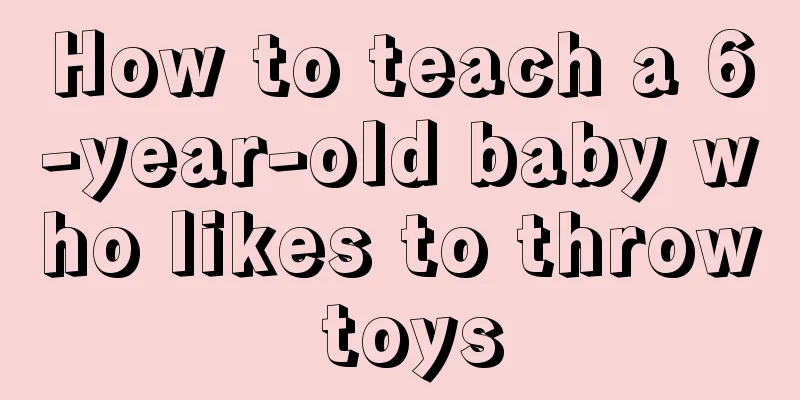Why do newborns' fingernails turn black at the base? What is the reason?

|
The health of newborns cannot be neglected, and every detail must be carefully observed, such as the common fingernail problem. So what is the reason for the black roots of newborn fingernails? Blackening of the base of the newborn's fingernailsIf the base of the baby's nails turn black on the 9th day after birth, it is considered to be due to lack of oxygen. This symptom is most common in congenital heart disease. Of course, the possibility of inheritance cannot be ruled out. It is still necessary to go to the hospital for an examination. If heart problems can be ruled out, you will feel more at ease. Reasons why newborns like to suck their fingersAlmost every child has "eaten" his fingers. This is because in the development process of infants and young children, in the infant stage, children like to use their hands and mouths to explore and learn. We often see that after 6 months, babies often put things in their mouths to taste, which is very normal. Sometimes babies eat their fingers because they are not satisfied in the oral stage, so they use this method to vent or get compensation. Training newborn baby's finger movementsNewborns usually clench their fists tightly. At this time, parents can gently stroke their fingers or do finger massage exercises to stimulate the sensation of their hand skin. At 2 months, the baby's hands begin to loosen. At this time, you can continue to caress the baby's hands, from the wrists to the fingertips, and gently lift each finger. You can also put your index finger into his little palm, pull it out and put it back in, and repeat this several times. At 3 to 4 months old, children like to touch everything they can touch, grab things unconsciously, and often play with their fingers with interest. At this time, prepare some toys, such as toys with thin handles and sounds, let them look at them first, and then put them in their hands, so that the children can gradually associate what they see with the movements of their hands, stimulate them to develop the enterprising spirit of "reaching out when they see something", and produce conscious grasping movements of their fingers. At 5 to 6 months, the child can separate the thumb and other four fingers to grasp, can freely grasp the surrounding objects, and can use his fingers to grab the towel covering his face. At this time, you can train him to grab the toys on the table purposefully, shake and hit them; you can also prepare some elastic rubber toys for him to grab or pinch at will; you can also train him to hold the bottle with both hands when feeding. At 7 to 8 months, the child can transfer the toy from one hand to the other, and will not tire of knocking the table with the toy in his hand; he can hold two toys with both hands at the same time, put the objects he holds into his mouth, and gradually learn to take things with his fingers. At this time, parents should take advantage of the situation and teach the child to tear paper, clap, wave, shake hands, pinch sugar pills with fingers, and play folk games that develop finger movements, such as the chicken and bug flying with the index finger. At 9 to 10 months, the child will use the index finger and thumb to pick up small objects, especially like to put small beans into the bottle, pour them out, and then put them back. Parents should pay attention to safety at this time. At the same time, the child will point to the questions asked by the parents, such as where is the light? He will point with his fingers. At this time, you can train the child to look in the mirror and identify his facial features, learn to peel candy wrappers, play with rings, put small boxes into large boxes, play with building blocks, eat biscuits by himself, etc., to increase his perception of things. At 11 to 12 months, the child's two fingers can move freely, and the dexterity of their fingers is further improved. They can do different actions at the same time, such as holding bread with one hand and putting small sugar pills into the bottle with the other hand. At this time, you can train your child to rotate bottle caps, stack building blocks, doodle with crayons, learn to turn pages, string beads, etc. You can also train your child to eat with a spoon. |
<<: Can babies use electric blankets? Is it good for babies to use electric blankets?
>>: What is the reason for the yellowing of baby teeth? How to remove the yellowing of baby teeth
Recommend
Boys' names are handsome, indifferent and nice boys' names
A nice name can add a lot of charm to a person. M...
What to do if your milk is too thin? What are the reasons for low milk supply?
Generally, mothers will breastfeed their children...
2017 Kindergarten Outdoor Activities Lesson Plan 2017 Kindergarten Sports Meeting Plan
2017 Kindergarten Outdoor Activities Lesson Plan ...
What is the difference between artificial and test tube? The pros and cons of test tube babies
Many people mistake artificial insemination for I...
6 reasons why babies like to scratch their ears
Although babies can't speak, they can tell us...
Can babies eat cauliflower? At what age can babies eat cauliflower?
Cauliflower is a vegetable rich in nutritional va...
At what age should babies start getting self-paid vaccines? Where can babies get self-paid vaccines?
For the safety of your baby, in addition to the v...
What is the cause of lung heat in children? What should we do if children have lung heat?
Children are always prone to illness because of t...
How should pregnant women take care of themselves? The second
Many pregnant women do not have very good physica...
What are the methods for removing phlegm from infants and young children? Four methods are recommended
Many infants and young children have phlegm in th...
Will choosing the time for caesarean section and the baby's birth date be accurate?
Many expectant parents or elders, because they ar...
How old should you wear diapers? How old should you wear diapers?
Diapers are a must-have product for babies. Today...
How long is it appropriate for children to play in the water? How often should children play in the water?
How long is appropriate for children to play in t...
What should I do if my child keeps coughing? How can I stop my child's cough quickly?
Children usually don't know how to take care ...
Does Blue Moon laundry detergent have a shelf life? How to open the lid of Blue Moon laundry detergent?
I bought some Blue Moon laundry detergent and it ...









